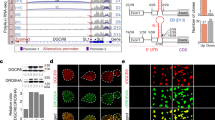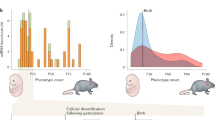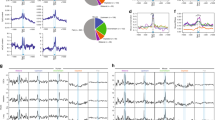Abstract
Dgcr8 knockout embryonic stem (ES) cells lack microprocessor activity and hence all canonical microRNAs (miRNAs). These cells proliferate slowly and accumulate in G1 phase of the cell cycle1. Here, by screening a comprehensive library of individual miRNAs in the background of the Dgcr8 knockout ES cells, we report that multiple ES cell–specific miRNAs, members of the miR-290 family, rescue the ES cell proliferation defect. Furthermore, rescued cells no longer accumulate in the G1 phase of the cell cycle. These miRNAs function by suppressing several key regulators of the G1-S transition. These results show that post-transcriptional regulation by miRNAs promotes the G1-S transition of the ES cell cycle, enabling rapid proliferation of these cells. Our screening strategy provides an alternative and powerful approach for uncovering the role of individual miRNAs in biological processes, as it overcomes the common problem of redundancy and saturation in the miRNA system.
This is a preview of subscription content, access via your institution
Access options
Subscribe to this journal
Receive 12 print issues and online access
$209.00 per year
only $17.42 per issue
Buy this article
- Purchase on Springer Link
- Instant access to full article PDF
Prices may be subject to local taxes which are calculated during checkout





Similar content being viewed by others
References
Wang, Y., Medvid, R., Melton, C., Jaenisch, R. & Blelloch, R. DGCR8 is essential for microRNA biogenesis and silencing of embryonic stem cell self-renewal. Nat. Genet. 39, 380–385 (2007).
Keller, G. Embryonic stem cell differentiation: emergence of a new era in biology and medicine. Genes Dev. 19, 1129–1155 (2005).
White, J. & Dalton, S. Cell cycle control of embryonic stem cells. Stem Cell Rev. 1, 131–138 (2005).
Burdon, T., Smith, A. & Savatier, P. Signalling, cell cycle and pluripotency in embryonic stem cells. Trends Cell Biol. 12, 432–438 (2002).
Sabapathy, K., Klemm, M., Jaenisch, R. & Wagner, E.F. Regulation of ES cell differentiation by functional and conformational modulation of p53. EMBO J. 16, 6217–6229 (1997).
Sorrentino, E., Nazzicone, V., Farini, D., Campagnolo, L. & De Felici, M. Comparative transcript profiles of cell cycle-related genes in mouse primordial germ cells, embryonic stem cells and embryonic germ cells. Gene Expr. Patterns 7, 714–721 (2007).
Stead, E. et al. Pluripotent cell division cycles are driven by ectopic Cdk2, cyclin A/E and E2F activities. Oncogene 21, 8320–8333 (2002).
White, J. et al. Developmental activation of the Rb-E2F pathway and establishment of cell cycle-regulated cyclin-dependent kinase activity during embryonic stem cell differentiation. Mol. Biol. Cell 16, 2018–2027 (2005).
Murchison, E.P., Partridge, J.F., Tam, O.H., Cheloufi, S. & Hannon, G.J. Characterization of Dicer-deficient murine embryonic stem cells. Proc. Natl. Acad. Sci. USA 102, 12135–12140 (2005).
Shcherbata, H.R. et al. The MicroRNA pathway plays a regulatory role in stem cell division. Cell Cycle 5, 172–175 (2006).
Chen, C. et al. Defining embryonic stem cell identity using differentiation-related microRNAs and their potential targets. Mamm. Genome 18, 316–327 (2007).
Houbaviy, H.B., Murray, M.F. & Sharp, P.A. Embryonic stem cell-specific microRNAs. Dev. Cell 5, 351–358 (2003).
Houbaviy, H.B., Dennis, L., Jaenisch, R. & Sharp, P.A. Characterization of a highly variable eutherian microRNA gene. RNA 11, 1245–1257 (2005).
Suh, M.R. et al. Human embryonic stem cells express a unique set of microRNAs. Dev. Biol. 270, 488–498 (2004).
Calabrese, J.M., Seila, A.C., Yeo, G.W. & Sharp, P.A. RNA sequence analysis defines Dicer's role in mouse embryonic stem cells. Proc. Natl. Acad. Sci. USA 104, 18097–18102 (2007).
Kato, J. Induction of S phase by G1 regulatory factors. Front. Biosci. 4, D787–D792 (1999).
Lee, M.H. & Yang, H.Y. Regulators of G1 cyclin-dependent kinases and cancers. Cancer Metastasis Rev. 22, 435–449 (2003).
Savatier, P., Lapillonne, H., van Grunsven, L.A., Rudkin, B.B. & Samarut, J. Withdrawal of differentiation inhibitory activity/leukemia inhibitory factor up-regulates D-type cyclins and cyclin-dependent kinase inhibitors in mouse embryonic stem cells. Oncogene 12, 309–322 (1996).
Ambros, V. microRNAs: tiny regulators with great potential. Cell 107, 823–826 (2001).
Bartel, D.P. MicroRNAs: genomics, biogenesis, mechanism, and function. Cell 116, 281–297 (2004).
He, L. & Hannon, G.J. MicroRNAs: small RNAs with a big role in gene regulation. Nat. Rev. Genet. 5, 522–531 (2004).
Lewis, B.P., Shih, I.H., Jones-Rhoades, M.W., Bartel, D.P. & Burge, C.B. Prediction of mammalian microRNA targets. Cell 115, 787–798 (2003).
Lewis, B.P., Burge, C.B. & Bartel, D.P. Conserved seed pairing, often flanked by adenosines, indicates that thousands of human genes are microRNA targets. Cell 120, 15–20 (2005).
Li, Y. et al. Lats2, a putative tumor suppressor, inhibits G1/S transition. Oncogene 22, 4398–4405 (2003).
Voorhoeve, P.M. et al. A genetic screen implicates miRNA-372 and miRNA-373 as oncogenes in testicular germ cell tumors. Cell 124, 1169–1181 (2006).
Ivanovska, I. et al. MicroRNAs in the miR-106b family regulate p21/CDKN1A and promote cell cycle progression. Mol. Cell. Biol. 28, 2167–2174 (2008).
Benetti, R. et al. A mammalian microRNA cluster controls DNA methylation and telomere recombination via Rbl2-dependent regulation of DNA methyltransferases. Nat. Struct. Mol. Biol. 15, 268–279 (2008).
Sinkkonen, L. et al. MicroRNAs control de novo DNA methylation through regulation of transcriptional repressors in mouse embryonic stem cells. Nat. Struct. Mol. Biol. 15, 259–267 (2008).
Acknowledgements
We would like to thank A. D. Sharma and K. Okamura for their technical assistance with the immunoblot assay; M. Grskovic and C. Chaivorapol for their technical assistance with the luciferase reporter assay; M. Sachs for help in developing the overexpression construct; and M. Conti, M. Ramalho-Santos, J. Reiter and members of the Blelloch laboratory for critical reading of the manuscript. This work was supported by funds to R.B. from the US National Institutes of Health (K08 NS48118 and R01 NS057221), the Stem Cell Research Foundation and the Pew Charitable Trust. Y.W. is supported by a California Institute of Regenerative Medicine Training Grant.
Author information
Authors and Affiliations
Contributions
Y.W. performed all experiments except those shown in Figure 3a, which were done by J.E.B. S.B. developed and provided the miRNA mimic library. A.S. built mutant reporters for Figure 4. L.B. provided technical support. Y.W. and R.B. designed all experiments, analyzed data and wrote the manuscript.
Note: Supplementary information is available on the Nature Genetics website.
Corresponding author
Ethics declarations
Competing interests
Scott Baskerville was an employee of Dharmacon/Thermo Fisher at the time of this study. He, in the form of a collaboration, supplied the microRNA mimic library used in experiments described in the manuscript.
Supplementary information
Supplementary Text and Figures
Supplementary Figures 1–6 and Supplementary Tables 1 and 2 (PDF 2120 kb)
Rights and permissions
About this article
Cite this article
Wang, Y., Baskerville, S., Shenoy, A. et al. Embryonic stem cell–specific microRNAs regulate the G1-S transition and promote rapid proliferation. Nat Genet 40, 1478–1483 (2008). https://doi.org/10.1038/ng.250
Received:
Accepted:
Published:
Issue Date:
DOI: https://doi.org/10.1038/ng.250
This article is cited by
-
Targeting oncogenic microRNAs from the miR-371~373 and miR-302/367 clusters in malignant germ cell tumours causes growth inhibition through cell cycle disruption
British Journal of Cancer (2023)
-
Time-resolved Small-RNA Sequencing Identifies MicroRNAs Critical for Formation of Embryonic Stem Cells from the Inner Cell Mass of Mouse Embryos
Stem Cell Reviews and Reports (2023)
-
Highly sensitive and non-disruptive detection of residual undifferentiated cells by measuring miRNAs in culture supernatant
Scientific Reports (2022)
-
The roles of microRNAs in mouse development
Nature Reviews Genetics (2021)
-
CHD8 safeguards early neuroectoderm differentiation in human ESCs and protects from apoptosis during neurogenesis
Cell Death & Disease (2021)



